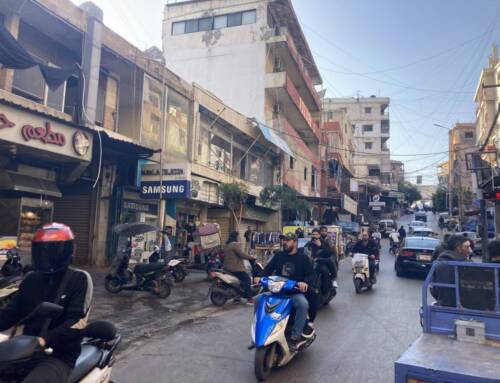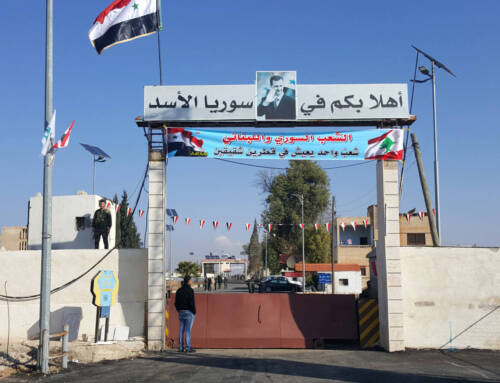Unable to afford rent, Syrians in Arsal on a ‘waiting list’ to move into tents
Under pressure from Lebanon’s economic crisis, 500 Syrian families in the past year have requested permits from the Arsal municipality to move from houses or apartments to informal tent settlements.
18 May 2022
ARSAL – On a clear spring morning, as the last snows melted off the peaks encircling Arsal, in northern Lebanon, Saleh Abdulwahed carried a brick and placed it delicately on the ground. “This will be the corridor, and here we will have two rooms,” the 52-year-old Syrian refugee explained while his sons added water to a mortar mixture.
Since the Abdulwahed family fled their hometown in Qalamoun in 2013, they have lived in several apartments in Arsal. But after nine years of displacement, they can no longer afford rent and are moving for the first time to a tent in an informal settlement.
They are among 500 Syrian families that have requested a permit from Arsal’s municipality to downgrade from a house or apartment to a tent in the past year. A crushing economic crisis in Lebanon since 2019 has driven nine out of ten Syrian refugees into extreme poverty.
Saleh, his wife and their eight children are moving into a tent that, in accordance with Lebanese authorities’ rules, is made of non-permanent materials like wood and plastic, with brick walls less than a meter tall (except for the bathroom). “In ten days, we will be living here,” Saleh said, standing in the middle of the unfinished tent’s wooden skeleton.
In Syria, Saleh used to work in commerce, but in Lebanon he has struggled to find work. “We are moving from a house to a tent just to be able to live,” he said. “I can’t pay rent anymore and UNHCR aid is not enough.”
Their monthly rent for their apartment was 1 million LBP ($34 at the current parallel exchange rate), while the combined rent for the two tents the eight members of this family will occupy is 400,000 LBP ($13). “In the houses you have to pay for all the expenses, while at the camp, the Norwegian Refugee Council (NRC) helped us with the wood and other NGOs will support us,” Saleh explained. NRC has provided 150 families with tent-building materials in the last year.
Plastic and wooden tents leave refugees vulnerable to Arsal’s harsh winters, but Saleh seemed optimistic. “In the tents in the camps, the winter is warmer than in the houses.” A neighbor who had been watching the family build their tent jumped in, saying: “It’s not like that, believe me, here it was very cold.” Saleh took a moment. “I don’t know—I have never been in a camp, it’s my first time,” he conceded.
“I wish I could go back to the building where I lived in Syria,” he added. The family cannot return to Syria because three of their older sons would face military conscription.
Half of the two dozen tents in this informal settlement are new. Iman Daimis’ tent neighbors the one Saleh is building. “We decided to move to a camp when we weren’t able to pay rent for several months,” Iman, originally from Idlib, explained. “The first time we came to the tent it was very difficult, we still haven’t gotten used to it.”

This informal settlement in Arsal has expanded to accommodate Syrian families that can no longer afford rent, 13/5/2022 (A. Medina, Syria Direct)
Iman, her husband, their three children and her mother-in-law moved into a tent last winter. The income of her husband, who works intermittently in a quarry, and UNHCR monthly assistance was not enough to cover their $50 rent. Now they pay 200,000 LBP ($6.60) for a tent. “We get electricity from a solar panel, and the UN provides water,” she explained.
In 2021, 21 percent of Syrian households in Lebanon that relocated did so due to eviction. The number of Syrians under eviction notice has grown steadily from 2.7 percent in 2018 to 3.7 percent in 2019, and from 4.9 percent in 2020 to 5.4 percent in 2021, according to UN figures.
Sunlight filtered through holes in the tarp roof of Iman’s tent. “Two days ago, it rained a lot, and we were scared, water came in through the corners,” she said. Without enough insulation, “the kids were crying from the cold this winter,” she added.
The logistics of shelter downgrading
Iman and Saleh’s families spent four and two months respectively waiting for Lebanese authorities’ approval for them to relocate to a tent. To move to a tent, Syrians must get the landowner’s approval and then request a permit from the Arsal municipality.
“They present their case proving they can’t pay rent in their apartment and they want to build a tent in a camp, then the municipality does a checkup to corroborate their case,” Ruwaida Fleety, from the Emergency Response Unit in NRC Arsal explained. The municipality refers the file to the intelligence services for security approval, and finally organizations such as the NRC provide materials to build a tent.
“Those who had low rents have seen their rent increase, and those who weren’t asked to pay rent now have to pay,” explained Fleety.
In December 2021, the Lebanon’s Interior Ministry forbade the expansion of camps in Arsal, “but given the circumstances, in February 2022, they issued an exception [in Arsal] allowing people to set up a tent,” Fleety said.
Arsal is located in the Baalbek-Hermel governorate, which hosts some 340,000 Syrian refugees, 53 percent of whom live in non-permanent shelters compared to 22 percent across the country. As of 2021, 57 percent of Syrian households live in shelters below humanitarian standards. The following graph shows a steady decrease of Syrians living in residential structures (houses), while the percentage of non-permanent shelters (tents) has increased over the years, although the impact of Arsal’s recent trend is not yet reflected.
According to the 2021 Lebanon Crisis Response Plan, the shelter sector has been “massively underfunded, leaving a large proportion of Syrian refugees in inadequate shelter at a time of a deepening economic crisis.” In 2021, the total funding requirements were more than $5.8 billion, of which 32.9 percent was covered. Out of 13 sectors, food security and education received the most funding, while the shelter sector ranked eighth with more than $31.7 million needed, of which only 18.6 percent was covered.
Monthly rent at the informal settlements was 50,000 LBP in recent years, but has risen to 200,000 LBP ($6.60). “Still, it is way more affordable than houses,” Fleety explained. “In some camps, the rent is paid by local NGOs and they receive more help like food boxes or mazot than in the houses,” Fleety explained.
Still on a waiting list
Kawthar Khalaf and Ahmad Muhammad live in a windowless garage in Arsal with their 11- and 12-year-old sons. The family, originally from Homs, fled to Lebanon in 2011. First they lived in apartments, three years ago they moved to a garage, and now they are on the waiting list to get a tent.
“We live day by day,” Kawthar said. With Ahmad’s sporadic work in agriculture and UNHCR assistance, they cannot keep up with their 300,000 LBP ($10) rent, 300,000 LBP ($10) electricity bill or the weekly 150,000 LBP ($5) cooking gas expenses. “It’s a difficult life, the help we get doesn’t last ten days, I can’t afford a kilo of yogurt, and bread is now 13,000 LBP,” Ahmad said.
Since October 2019, food prices in Lebanon have risen 404 percent, putting them out of reach for many, especially for the 88 percent of Syrians that live on less than 490,000 LBP ($16.30) per month.
Sabah Muhammad Matar is also anxiously waiting approval to move to a tent. She lives in a ground floor apartment in Arsal with her 25-year-old son Suleiman, his wife and two children. After Sabah’s husband was forcibly disappeared in Syria in 2011, the family fled their home in al-Qusayr, Homs in 2012 and found safety in Lebanon. They live off monthly UNHCR assistance.
The family’s residence consists of one room and a patio with a kitchen and bathroom. They only get state-provided electricity, that is, one hour per day. On their window, two small solar panels charge a little bulb. “Look at the humidity on the wall. In the winter the rain seeps in through this wall,” Suleiman said. “The kids got asthma because of that,” Sabah added. “In the winter, there’s no difference between staying inside or outside.”
They pay 500,000 LBP ($16.6) in rent, but their landlord is now asking for 700,000 LBP ($23.30). “Since the winter, we’ve been waiting to get approval to move to a tent,” Suleiman said. “People in the camps get food boxes, and here we didn’t get anything for two years,” Sabah added.
The building has a sewage problem, and the septic tank constantly overflows. “Yesterday we were choking from the smell of sewage,” Sabah said.
“The camp can’t be worse than this.”







